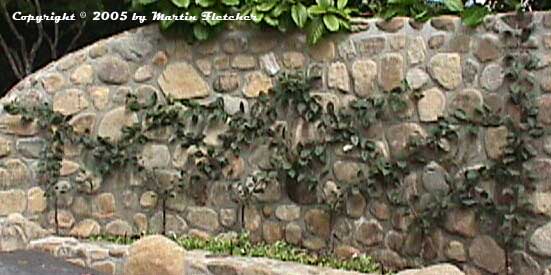Belgian Fence
This Belgian Fence was easy to construct. Apple trees can be shaped like almost anything. They are one of the easiest trees to directionally prune. For this Belgian Fence trees were planted 2.5 feet apart along the base of the wall. I cut them off at the same height, a foot above the ground. It is essential to cut the trees above the graft. Red Vein Crabapples were recommended for a Belgian Fence Espalier. They have 1.5 inch crab apples that can be made into a wonderful apple sauce. During the summer I only allowed 2 branches to grow. I rubbed off any other shoots before they ever got going. I put eyebolts into the wall on an even spacing. When the branches got long enough to reach I tied them to the eyebolts. The bolts were quickly covered by the trees. I used twine to loosely tie the branches to the eyebolts but I tied them snugly one another. Each year after this I only allowed fruiting spurs to grow. All of the other branches got rubbed or cut off so the Belgian Fence lattice shape can be seen. Eventually the branches will graft themselves together if they are bound together at the eyebolts. After a few years the ties can be removed entirely. I made several apple arches and arbors. All were easy to construct. The trees cooperate with almost any degree of pruning. And this allows for more types of trees. My inspiration was driven by my pleasure in tasting ever more varieties of apples fresh from the garden.

